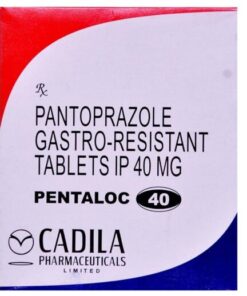Description
Aciloc is a brand of medication that contains cimetidine, a type of drug known as a histamine-2 receptor antagonist (H2RA). It is primarily used to treat and prevent various conditions related to the stomach and intestines, such as heartburn, indigestion, and stomach ulcers. Aciloc works by reducing the amount of acid produced in the stomach, which can help alleviate symptoms and promote healing. It is generally considered safe when taken as directed, but it’s essential to follow your doctor’s instructions and inform them about any other medications you’re taking, as Aciloc can interact with certain drugs.
BENEFITS
Aciloc, containing the active ingredient cimetidine, offers several benefits for managing and preventing gastrointestinal issues. Some of the main benefits include:
- Reducing stomach acid production: By inhibiting the action of histamine-2 receptors, Aciloc helps decrease the amount of acid in the stomach. This can help alleviate symptoms such as heartburn, indigestion, and acid reflux.
- Healing gastric ulcers: By lowering stomach acid levels, Aciloc can promote the healing of gastric ulcers, which can be caused by excessive acid production.
- Preventing ulcers caused by NSAIDs: Nonsteroidal anti-inflammatory drugs (NSAIDs) can irritate the stomach lining and increase the risk of ulcers. Aciloc can help protect the stomach lining and prevent ulcers caused by NSAIDs.
- Managing gastroesophageal reflux disease (GERD): Aciloc can help alleviate the symptoms of GERD, a chronic condition that causes stomach acid to flow back into the esophagus, leading to heartburn and other discomforts.
- Treating and preventing peptic ulcers: Aciloc can be used to treat active peptic ulcers and prevent the recurrence of ulcers in individuals who have a history of the condition.
- Safe for long-term use: Aciloc is generally considered safe for long-term use when taken as directed by a healthcare professional.
SIDE EFFECTS
- Headache: Some people may experience mild to moderate headaches while taking Aciloc.
- Dizziness: Dizziness or lightheadedness may occur in some individuals.
- Diarrhea: Aciloc may cause mild to moderate diarrhea in some people.
- Nausea and vomiting: Some individuals may experience nausea or vomiting as a side effect of Aciloc.
- Rash: A skin rash may develop in some people taking Aciloc.
- Fatigue: Some individuals may feel more tired than usual while taking Aciloc.
In rare cases, more severe side effects may occur, such as:
- Liver problems: Aciloc may cause liver dysfunction or jaundice in some people.
- Blood disorders: There is a small risk of developing blood disorders, such as thrombocytopenia or leukopenia, while taking Aciloc.
- Gynecomastia: In men, Aciloc may lead to the development of breast tissue (gynecomastia).
- Allergic reactions: Some people may have an allergic reaction to Aciloc, which can cause symptoms such as hives, itching, difficulty breathing, or swelling of the face, lips, tongue, or throat.
If you experience any side effects while taking Aciloc, it’s essential to consult with a healthcare provider to determine the appropriate course of action. They may recommend adjusting the dosage, switching to a different medication, or monitoring the side effects more closely.
HOW TO USE:
- Tablets and capsules: Aciloc tablets and capsules are usually taken by mouth with a glass of water, without regard to food. The typical adult dosage for treating gastroesophageal reflux disease (GERD) or peptic ulcers is 800 mg (two 400 mg tablets or capsules) taken at bedtime. For preventing ulcers caused by NSAIDs, the recommended dosage is 400 mg taken four times a day, with the last dose at bedtime.
- Syrup: Aciloc syrup is taken by mouth, usually with a glass of water or juice. The typical adult dosage for treating GERD or peptic ulcers is 400 mg (8 teaspoons of syrup) taken four times a day, with the last dose at bedtime. For preventing ulcers caused by NSAIDs, the recommended dosage is 400 mg (8 teaspoons of syrup) taken four times a day, with the last dose at bedtime.
- Duration of treatment: The duration of Aciloc treatment will depend on the specific condition being treated. For treating GERD or peptic ulcers, the typical course of treatment is 4-8 weeks. To prevent ulcers caused by NSAIDs, Aciloc may be taken long-term, as directed by your healthcare provider.
- Storage: Aciloc should be stored at room temperature, away from moisture and heat. Keep the medication out of reach of children and pets
PRECAUTIONS:
- Inform your healthcare provider about any medical conditions you have, including kidney or liver problems, as well as any medications you are currently taking, as these factors may affect the safety and efficacy of Aciloc.
- Take Aciloc exactly as prescribed by your healthcare provider. Do not increase or decrease the dosage without consulting your doctor.
- Avoid consuming alcohol while taking Aciloc, as it may increase the risk of side effects such as dizziness and drowsiness.
- Be aware of the potential side effects of Aciloc, which may include headache, dizziness, diarrhea, and rash. If these symptoms persist or worsen, consult your healthcare provider.
- Inform your healthcare provider if you are pregnant, planning to become pregnant, or breastfeeding, as the safety of Aciloc during pregnancy and breastfeeding has not been established.
- Do not dispose of Aciloc or any unused medication in the trash or down the drain, as this can harm the environment. Consult your pharmacist or local waste disposal guidelines for proper disposal methods.









28 reviews for Aciloc (Ranitidine)